It’s the end of the summer and time for the kids to start school, whether they’re staying home or attending in person this year. So how do you combine school’s three R’s of reading, writing and ‘rithmetic with the planet’s three R’s of reduce, reuse, and recycle?
Here are 10 green back-to-school tips for a healthier school year.
- 1. Get new school clothes second hand.
- 2. Inventory your supplies before buying more.
- 3. Choose non-toxic and eco-friendly school supplies.
- 4. Buy used textbooks.
- 5. Pack a lunch.
- 6. Use a non-toxic lunch box and water bottle.
- 7. Ditch the toxic hand sanitizers.
- 8. Green the school commute.
- 9. Don't idle your car in front of school.
- 10. Explain to your kids why you're making greener, healthier choices.
1. Get new school clothes second hand.

Kids outgrow clothing very quickly, so buying new clothes from retail stores not only wastes a lot of money for very little value, but “fast fashion” also contributes greatly to both sweatshop labor and environmental degradation from the GMO crops, oil-based synthetic fabrics and toxic dyes used to make them. In fact, the clothing industry is the second largest polluter in the world—second only to oil!
A great way to get new school clothes for free is to organize a clothing swap with family, friends or neighbors. Some communities have “Swap, Don’t Shop” events every fall, but if there isn’t one where you live, consider organizing one yourself!
If a swap won’t work, purchasing clothing from flea markets, consignment shops and thrift stores not only embodies the eco-friendly principle of “reuse”, it’ll also save you a lot of money.
My favorite second-hand option is ThreadUp, because you can save time and gas by shopping online for high quality “new-to-you” clothes for yourself and your child.
2. Inventory your supplies before buying more.
Take a careful inventory of the school supplies you already have that can be used again. Do you have extra packs of pencils, or barely used notebooks? Do you really need a new ruler? Is last year’s backpack still fully functional? Is that lunchbox still in great shape?
Reduce your consumerism and avoid last-minute impulse purchases by making a list of what you really need before you go to the store, and stick to it!
3. Choose non-toxic and eco-friendly school supplies.

PVC, also known as vinyl, contains chemical additives including phthalates that are linked to asthma, learning disabilities, diabetes and other chronic health problems. Congress banned phthalates in children’s toys, yet they are widespread in school supplies like lunch boxes, backpacks and three-ring binders.
Choose backpacks made of recycled PET or natural canvas, and avoid the shiny, plastic models that often contain PVC. (They will last longer, too!)
It’s harder to find binders that are not made of vinyl, but look for brands that are labeled PVC-free.
Some crayons that are imported from China have been found to be contaminated with asbestos. Choose crayons that have been manufactured in the United States.
More and more retailers are carrying eco-friendly versions of every day school supplies, so choose recycled pencils and markers, refillable or recycled pens, and 100% recycled, chlorine-free notebooks and printer paper, too.
4. Buy used textbooks.
Used textbooks are often available for half off or more in campus bookstores, and websites such as eCampus and Amazon Textbook Rentals also carry a broad selection of used titles. Renting or buying used textbooks is an increasingly popular option that helps to reduce the amount of books being created, which can save millions of trees.
In fact, according to the Environmental Paper Network, if the U.S. reduced its paper consumption by 10 percent annually, we could save enough energy to power 228,000 homes, conserve 11 billion gallons of water, and prevent carbon emissions equivalent to removing 279,000 cars from the road! Choosing used textbooks can help.
5. Pack a lunch.
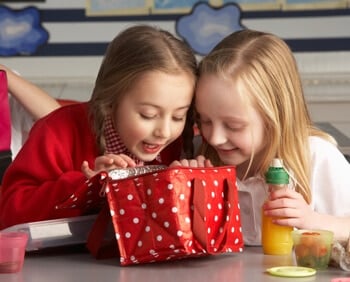
The average elementary school disposes of 20,000 pounds of lunch waste every year. That’s 10 tons of trash per school!
By packing a whole food lunch for your child in a reusable lunch box with a reusable bottle of water or milk, you will help reduce the amount of paper bags, food packaging and wasted food your child produces—and they will be so much healthier for it too.
Making a lunch made with whole food (and not packaged, processed food) doesn’t have to be hard or time consuming. Get your kids involved in choosing lunch ingredients, so they’ll be less likely to pitch stuff they don’t want to eat.
You can get tons of easy, healthy ideas for what to pack in your child’s lunchbox at these sites:
6. Use a non-toxic lunch box and water bottle.
Most plastic lunch boxes and water bottles contain toxic BPA, PVC or phthalates that cause health problems. Some plastic lunch boxes may even contain lead! Plastic is also made from petroleum, so it is an inherently unsustainable and polluting material, even if it happens to be “BPA-free.”
Instead of plastic, I highly recommend Planet Box stainless steel lunch boxes and water bottles. Stainless steel lunch boxes will last for many years, are easy to wash, and won’t leach toxic plastic chemicals into your child’s food. They also keep foods separated from each other without the need for plastic baggies, so if you have picky children who won’t eat any foods that touch each other, they will be very happy with this lunchbox.
7. Ditch the toxic hand sanitizers.
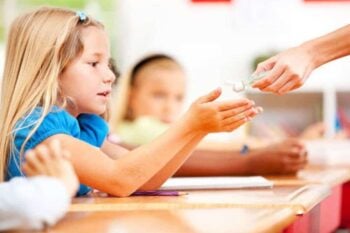
Most classrooms contain a bottle of hand sanitizer to help reduce the spread of germs, and some parents send them along with their kids to school. Hand sanitizers are good at killing germs, but they also contain toxic chemicals like triclosan, parabens and phthalates that can disrupt thyroid and immune system function, and encourage bacterial resistance to antibiotics.
Choose a natural hand sanitizer like the one by Babyganics, make your own with this easy recipe, or stick to good old-fashioned soap and water.
8. Green the school commute.
To help reduce air pollution—a major contributor to childhood asthma—investigate whether you live on or close to the school bus route. Even if your child stays late for chess club or soccer practice, most schools have an extended bus schedule to accommodate.
If you live less than a mile from the school, arrange a “walkpool” or a “walking bus,” where parents rotate chaperoning a group on foot (or bike) to and from school. You’ll save gas, reduce smog emissions, and you and your kids will get some exercise and maybe make some new friends in the process.
Finally, if walking, biking or the bus aren’t options at all, divide the ride and set up a carpool with your neighbors.
9. Don’t idle your car in front of school.
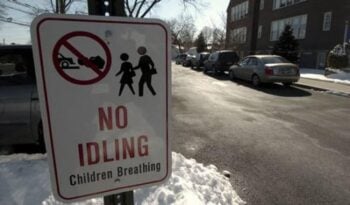
Idling your vehicle is a MAJOR source of smog. Smog is particularly an issue at schools because many bus drivers and parents sit with their vehicles idling while waiting to pick up their children, creating a huge cloud of pollution for them to walk into as they leave the building.
In fact, in children, smog has been found to:
- aggravate asthma, leading to more frequent and severe asthma attacks;
- increase the number of respiratory infections;
- aggravate and induce allergies;
- increase school day absences; and
- increase emergency room visits, hospital admissions and premature deaths.
It would be so much better if bus drivers turned off their buses until they were ready to go, and parents parked their cars and met their children at the school door.
If you are going to be stopped for more than 30 seconds (except in traffic), it’s always best to turn off your engine. Idling your vehicle for longer than 10 seconds uses more fuel than it would take to restart the vehicle, saving you money, too.
This article breaks down even further the major environmental and economic problems with idling your car.
10. Explain to your kids why you’re making greener, healthier choices.
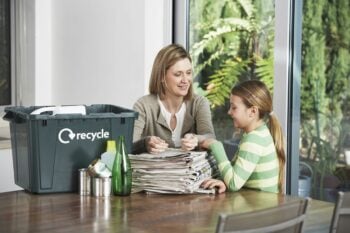
Making planet-friendly choices when getting ready for school is great, but what is even more awesome is teaching your kids why you’ve made those choices.
Sometimes, explaining how that shiny vinyl dinosaur backpack is full of toxic nasties or why that package of processed cookies pollutes and harms endangered animals is all it takes to calm a complaining child.
Hopefully, because of your thoughtful conversations with your kids, they will grow up to help create a world where such toxic and polluting products don’t exist in the first place.
Updated August 12, 2020



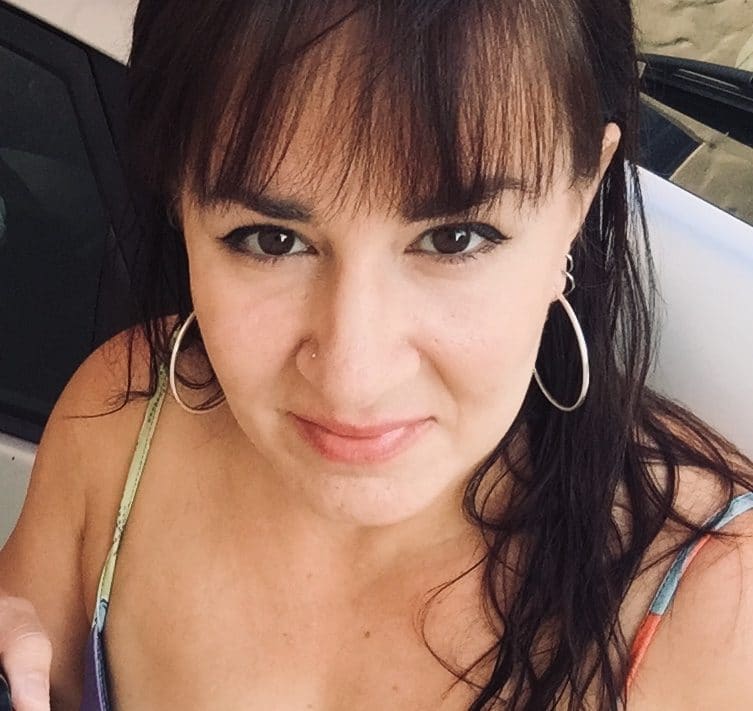




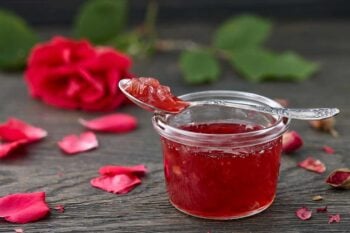
9 thoughts on “10 Tips for a Healthy, Eco-Friendly Back-to-School”